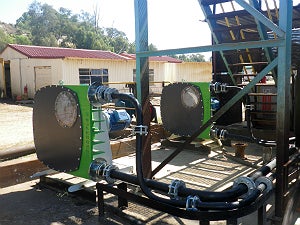
After decades of uncontrolled industrial (mining) activities, water supply is under serious threat. Studies show that acid water levels in the country’s mines are rising at a staggering average rate of 0.59 m/day. The water situation is in fact threatening the population’s survival. At the heart of resolving this problem is the treatment of water and wastewater.
This article looks at peristaltic dosing pumps used as part of the process to rectify the pH balance of acid mine water. It highlights a successful implementation at a uranium wastewater treatment plant, focusing on, but not limited to, the cost of ownership; plant performance (plant availability and reliability); and dosing accuracy.
The impact of acid mine drainage (AMD) is devastating, with far-reaching and long-term impact on the environment. According to recent research, AMD could not only impact South Africa’s quality of water, but also poison food crops, destroy heritage sites and lead to a decline in agricultural production with related job losses, to name but a few.
Peristaltic pumps for dosing lime
According to the experts consulted by the Department of Water Affairs, the most suitable process to consider in dealing with the current AMD issues is the ABC (alkali-barium-calcium) process, developed by South Africa’s Council for Scientific and Industrial Research (CSIR), which consists of the following steps:
- Lime and / or CaS pre-treatment
- Barium treatment for sulphate removal
- Sludge processing.
This is the most comprehensive treatment that will ensure that the treated water is fit to be introduced back into nature but is not necessarily suitable for human consumption.
The nature of the medium being pumped is an important factor when considering pump selection for a specific application. When pumping lime, the high viscosity of the medium often causes pumps to clog up, resulting in a maintenance nightmare.
Peristaltic pumps are a type of positive displacement pump used to convey a variety of fluids. The fluid is contained within a flexible hose fitted inside the pump casing. The actual pumping principle, called peristalsis, is based on alternating compression and relaxation of the hose, drawing content in and propelling product away from the pump, in the same way that food is pumped through the body. This process makes a peristaltic pump an accurate dosing or metering pump, with an equal amount of liquid dosed each time. Correcting the pH is a very specific process and the pump used for dosing must be very accurate. Peristaltic pumps have a linear flow-speed characteristic and excellent repeatability, making them the most accurate solution available.
The liquid being pumped never comes into contact with any moving parts because it is totally contained within the reinforced hose. A rotating shoe passes along the length of the hose creating a total seal between the suction and discharge sides of the pump. As the pump’s rotor turns, this sealing pressure moves along the hose, forcing product to move away from the pump and into the discharge line. Where the pressure has been released the hose recovers, creating a vacuum, which draws the product into the suction side of the pump, the priming mechanism. Combining these suction and discharge actions results in a self-priming positive displacement pump, the peristaltic pump. The perfect seal between the two sides of the pump means that there is no product slip; when coupled with the pump’s linear speed-how characteristic it makes peristaltic pumps ideal for dosing.
Additionally, as the pumped liquid is totally contained within the hose, this makes a peristaltic pump an environmentally safe pumping solution with zero chance for contamination. This also reduces maintenance time as the hose is the only wearing part.
The pulsation effect means that solids are kept in suspension. Build-up in the hoses is eliminated by using rubber hoses that are designed to maximise life expectancy and performance. Hose pumps are designed to handle these tough operating conditions, ensuring optimal process flow.

